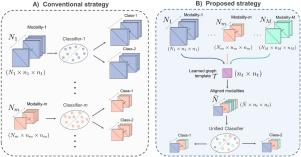Journal of Neuroscience Methods ( IF 2.7 ) Pub Date : 2020-12-10 , DOI: 10.1016/j.jneumeth.2020.109014 Abdullah Yalçin 1 , Islem Rekik 2

|
Background Presence of multimodal brain graphs derived from different neuroimaging modalities is inarguably one of the most critical challenges in building unified classification models that can be trained and tested on any brain graph regardless of its size and the modality it was derived from. Existing methods One solution is to learn a model for each modality independently, which is cumbersome and becomes more time-consuming as the number of modalities increases. Another traditional solution is to build a model inputting multimodal brain graphs for the target prediction task; however, this is only applicable to datasets where all samples have joint neuro-modalities. New method In this paper, we propose to build a unified brain graph classification model trained on unpaired multimodal brain graphs, which can classify any brain graph of any size. This is enabled by incorporating a graph alignment step where all multi-modal graphs of different sizes and heterogeneous distributions are mapped to a common template graph. Next, we design a graph alignment strategy to the target fixed-size template and further apply linear discriminant analysis (LDA) to the aligned graphs as a supervised dimensionality reduction technique for the target classification task. Results We tested our method on unpaired autistic and healthy brain connectomes derived from functional and morphological MRI datasets (two modalities). Conclusion Our results showed that our unified model method not only has great promise in solving such a challenging problem but achieves comparable performance to models trained on each modality independently.
中文翻译:

诊断统一分类模型,用于使用图对齐对多尺寸和多模态脑图进行分类
背景技术从不同的神经影像学方法获得的多峰脑图无疑是建立统一分类模型中最关键的挑战之一,该模型可以在任何脑图上进行训练和测试,而不论其大小和来源。现有方法一种解决方案是独立地为每个模态学习模型,这很麻烦并且随着模态数量的增加而变得更加耗时。另一个传统的解决方案是建立一个模型,为目标预测任务输入多峰脑图。但是,这仅适用于所有样本均具有关节神经形态的数据集。新方法在本文中,我们建议建立一个在不成对的多峰脑图上训练的统一脑图分类模型,该模型可以对任何大小的脑图进行分类。通过合并图对齐步骤,可以将所有不同大小和异构分布的多峰图映射到一个通用模板图,从而实现这一点。接下来,我们为目标固定尺寸模板设计图对齐策略,并进一步将线性判别分析(LDA)应用于对齐图,作为目标分类任务的监督降维技术。结果我们在源自功能和形态MRI数据集(两种方式)的不成对的自闭症和健康的大脑连接体上测试了我们的方法。结论 我们的结果表明,我们的统一模型方法不仅在解决这一具有挑战性的问题方面具有广阔的前景,而且可以实现与在每种模态下独立训练的模型可比的性能。











































 京公网安备 11010802027423号
京公网安备 11010802027423号